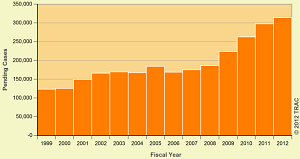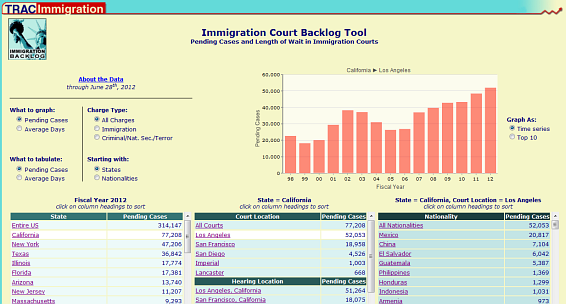
Figure 1. Immigration Court Backlog Click for larger image. |
The number of cases awaiting resolution before the Immigration Courts reached a new all-time high of 314,147 by the end of June 2012, according to very timely government enforcement data obtained by the Transactional Records Access Clearinghouse (TRAC). The case backlog has continued to grow — up 5.6 percent — since TRAC's previous report for data up to the end of September 2011, and 20 percent higher than levels at the end of FY 2010 (see Figure 1).
Wait times have also lengthened since our last report. The average time these pending cases have been waiting in the Immigration Courts of the Executive Office for Immigration Review (EOIR) is now 526 days, compared with 489 days at the end of fiscal year 2011 and 447 days at the end of fiscal year 2010.
Backlog by Charge
Despite ICE Director John Morton's June 17, 2011 directive on prosecutorial discretion — outlining the manner in which enforcement activity would focus on deporting serious criminals — the proportion of the Immigration Court's pending caseload made up of "criminal" cases has not increased, but instead has been steadily falling.
The latest data (current through the end of June 2012) reveal that in merely 7.9 percent of pending Immigration Court cases, ICE sought removal action on the basis of individuals charged with criminal activities, or actions adverse to national security, or aiding terrorism. This is down from the already low level of 8.3 percent at the end of fiscal year 2011, and 9.1 percent at the end of fiscal year 2010.
Thus, the vast majority of the current backlog involved individuals charged with violating immigration rules: for example, entering the country illegally, entering legally but overstaying their visas, or violating other procedural requirements. This category of pending case has rose sharply this year to 286,159. It was only 236,415 at the end of FY 2010, climbing to 270,159 at the end of September 2011.
Full details — by charge, state, nationality, Immigration Court and hearing location — can be viewed in TRAC's backlog application, now updated with data through June 28, 2012.

Figure 2. TRAC's Immigration Court Backlog Tool. (click to use the tool) See also TRAC's previous backlog report and listing of earlier TRAC report reports in this series beginning in 2008 examining the volume of cases, wait times, and the number of immigration judges available. |